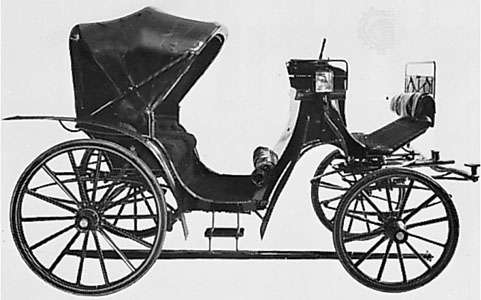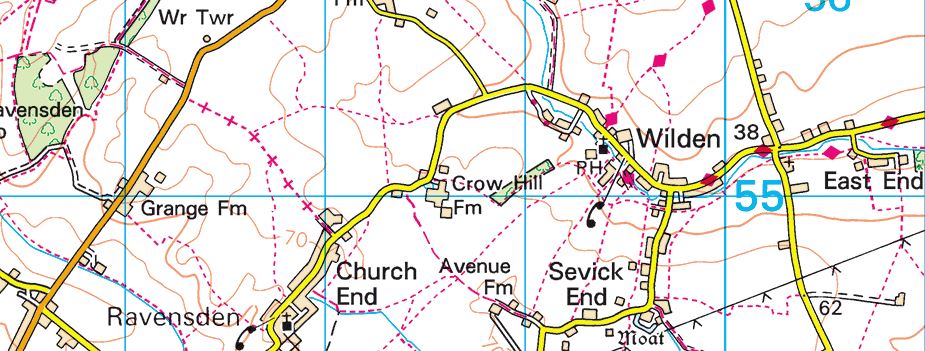Ghost or Fairy on the Road from Wilden to Ravensden? June 25, 2020
Author: Beach Combing | in : Modern , trackbackA Bedfordshire Account of the Impossible
I recently came across a terrifying encounter recorded about a road trip in Bedfordshire in the early 1870s. We are in Victorian England and Mrs Goodhall is riding with her daughter towards Bedford in a carriage. We should imagine Mrs Goodhall in the back seat and her daughter up high with the reins. Their respective positions might prove important.
Time, summer’s evening, towards the day’s wane, but still quite light. Place, the broad plateau of a high hill, between Willesden [Wilsden?] and Ravensden, on the road to the town of Bedford. Year, either 1873 or 1874. The road unusually wide, with deep margins of grass on both sides. I was being driven by my daughter in a low pony carriage, when I suddenly saw a figure, dressed in black from head to foot, advancing; it appeared to glide along. I said to my daughter, ‘Oh, do look at that strange figure!’ It passed on the left side of the carriage, on the grass, within two yards of us; as it did so, it turned its face directly our way, and of all the fiendish faces it was the most horrible you can imagine; its garments seemed to train [sic] behind it. My daughter looked back after it as it passed us; she says it turned its face over its shoulder, and looked towards us. I myself turned round immediately – it was gone. I told people in the county what we [p. 311] had seen, but could never learn any history beyond the saying of the people, that part of the road was supposed to be haunted. The figure passed about three-quarters of a yard beyond the roadway.
I was in good health and quite happy; age about 50.
(The figure had) no likeness to any one I ever had seen or have seen since.
My daughter, who was driving me at the time, confirms my statement. (Miss Goodhall adds here a note: ‘I do. – Signed – May C. Goodhall’).
I took no notes of the experience, but often spoke of it to others at the time, and also since.[1]
Reflections
There are a few remarkable features here. Not least the fact that two people saw something impossible simultaneously. The first time I read this I wondered whether there was not someone really there: a travelling beggar perhaps shocking the middle-class Goodhalls. The gliding could be suggested by an unusual long coat and the uncut grass might have added to the effect, but then, as Mrs Goodhall writes, ‘it was gone’. Perhaps the hypothetical tramp just rolled into a ditch? Mrs. Goodhall would have had more trouble seeing the passer-by than her daughter, particularly if the cover on her carriage was up. I imagine the daughter turned, saw, turned back to adjust the horse(s) and to escape the man’s stare and that it was then that her mother looked round and saw nothing. Did they stop the coach to check?
‘High hill’ in Bedfordshire is – and I say this with great respect to readers in Beds – a relative term. (I grew up in the Pennines and am presently living in the midst of some Italian hills.) But this is the most likely point on the road? The landscape has barely changed here in 150 years. The house on the right is Crow Hill Farm or a near neighbour. How long did ‘it’ walk towards the two women? Why did they only see the face when ‘it’ turned? Was there a hood?
Note the way, too, that Mrs. Goodhall repeatedly refers to an ‘it’ rather than a human being. Were these her original words, or just the constant massaging of memory in the intervening years?
What Was IT?
The Crow Hill Ghost then? Maybe. It gets you thinking, though, about how we classify the supernatural. I have several accounts like this from Britain and Ireland where unusually dressed humanoids (or humanoids acting in a strange way) suddenly vanish: this is the clincher, of course, demonstrating that they are not human. Some are called ‘fairies’; some are called ‘ghosts’. I am fascinated by how arbitrary the differences are. I couldn’t honestly say why we should pick one or the other here (or in most other cases). My guess is that had this happened in the Highlands or Cornwall in 1873, the Goodhalls’ fragment of nightmare would have been assimilated to fairydom: as it was locals talked vaguely about a haunting.
My middle daughter (9) came in to criticise how I was laying this blog out. She said, as if it was extraordinarily obvious, ‘Dad, it’s Death’. We then came up with a scenario where Death was coming back to look for the scythe he’d dropped. He dipped down to pick it up and that’s why he appeared to suddenly disappear from view. Mystery solved.
A curiosity. One point that I often note is whether or not there is interaction between the witness and the ‘thing’. Here there is interaction. ‘It’ turns to look twice. The looking over the shoulder particularly doesn’t seem very, well, supernatural. But don’t tell Death I said that.
Plug
I’ve just published this account (and the subsequent stolid but inconclusive examination of the Society for Psychical Research in their Census of Hallucinations) with other Bedfordshire spook yarns in a collection: Ghost Tales from Victorian and Edwardian Bedfordshire: Seven Stories from the Bedfordshire Twilight. You can get it via Lulu or Amazon. I’m slowly doing all the British counties. This is by far the shortest account but, to my tastes, Mrs Goodhall’s run in with the uncanny is one of the scariest. I’d be particularly interested in any local information: after all the ‘road was supposed to be haunted’. Please write to drbeachcombing AT gmail DOT com. I couldn’t get the comments to work so I’m giving up on that. Probably for the best.
I’m also slowly replying to the kind emails sent in. It has been great, really great to read them all. Thanks so much.
[1] ‘Report on the Census of Hallucinations’, Proceedings of the Society for Psychical Research 10 (1894), 25-422 at 310-311.
For more on Pwca Ghost, Witch and Fairy Pamphlets





